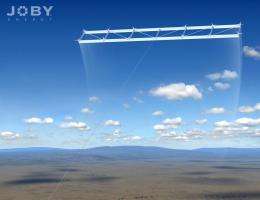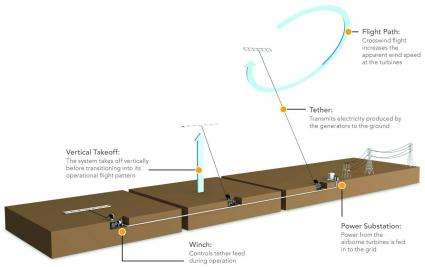June 4, 2010 report
Airborne wind turbines to generate power from high winds (w/ Video)

(PhysOrg.com) -- Airborne wind turbines may soon be generating power from high-altitude winds to provide consistent, clean, cheap, and abundant energy for a power-hungry world.
Mr Bevirt of airborne wind turbine company Joby Energy, said wind power is a great source of energy, with an estimated 870 terawatts being carried in the tropospheric winds. This potential is considerably greater than the 17 terawatts of current global demand.
The idea of using winds at high altitudes to generate power was first suggested around four decades ago but at the time was not technically feasible. Now, with new materials and more advanced computers, electronics and sensors, and the development of unmanned aircraft, the concept may be viable, and several companies are investigating the best ways to tap into the resource to generate renewable energy cheaply. Joby Energy is one of these, and its design looks like a multi-winged kite supporting an array of turbines.
The thrust required for the kite's vertical take-off is supplied by motor-generators connected to the turbines, and the orientation of the kite to the wind is controlled by a computer system that differentially adjusts rotor speeds to keep it flying in a circular path. The winds flowing through the turbines spin the generators at high speed, so there is no need for gearboxes. The electricity generated by the turbines is transmitted to the ground via the reinforced composite tether that anchors the kite to the ground.
The airborne turbines would initially fly at a height five times higher than conventional wind turbines, and this would increase access to higher wind speeds and better wind consistency, giving more reliable power supplies. If the turbines were flown higher the power generated could be even greater because the wind speed tends to increase at higher altitudes.
The US Federal Aviation Administration has restricted the altitude initially to 600 meters or less, even though the airborne turbines can in theory fly at altitudes over 10,000 meters, and they are designed to operate in the upper troposphere and upper boundary layer.

After testing over 20 designs the company has selected a 30 kW system for evaluation and testing. If the tests are successful the company plans to test a 100 kW prototype, and then an initial set of turbine arrays generating 300 kW, enough to supply power to about 150 homes. The generated DC electricity transferred to the ground via the tether would then be converted to AC power to be fed into the power grid.
Bevirt said the system is designed to withstand strong winds, and in gale-force winds or periods of no wind at all the array would be programmed to land itself and take to the air again when the wind conditions are more suitable. The kite is also designed to be landed safely even if the tether is broken, using batteries to power its motors. The design includes a high degree of redundancy in the array, which means it can remain in the air even with multiple points of failure.
The eventual goal of Joby Energy is to develop wind farms with several arrays to develop consistent power, but it will first need to demonstrate the system is safe and the control systems are reliable. Bevirt said the ultimate aim is to deploy the wind turbines around the world to produce an abundant global supply of cheap and clean electricity.
More information: Joby Energy: www.jobyenergy.com/tech
© 2010 PhysOrg.com
















